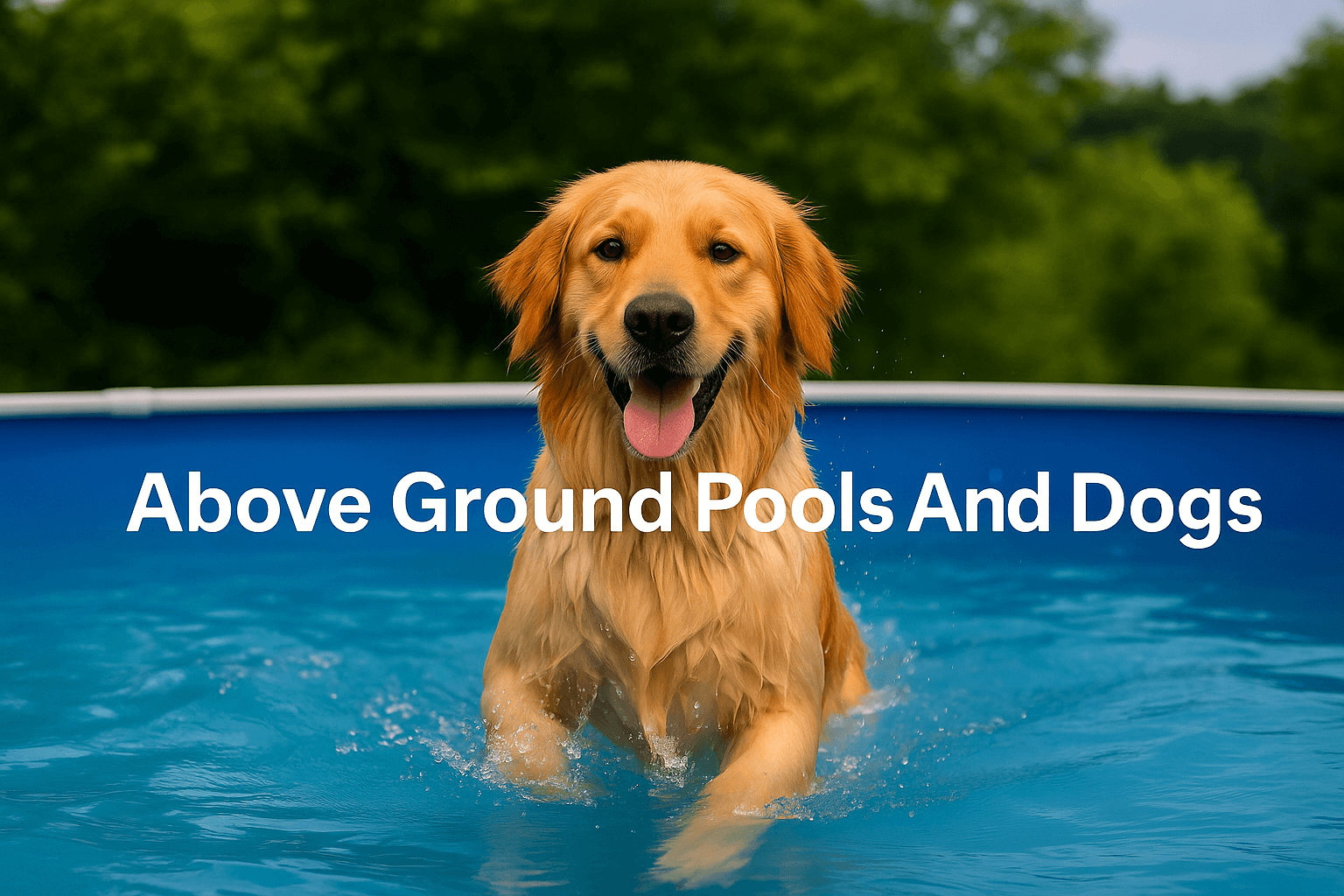
Above Ground Pools And Dogs
Dogs + above ground pools = summer chaos or pure joy?
Short answer: Yes, dogs can enjoy Pools UK-style above ground pools—safely.
From splashy zoomies to paw-safe ramps, we’ve got all the tips to keep tails wagging and your pool in one piece.
Let’s dive into everything you need to know to make pool time safe, clean, and completely unforgettable for you and your four-legged mate.
Keeping Your Dog Safe in and Around the Pool
The Dangers of Above Ground Pools for Dogs
Drowning and Exhaustion Risks
Even the most water-loving dogs can get caught off guard in a pool.
They might struggle to climb out or tire themselves trying to stay afloat—especially if there’s no easy exit.
Think about it: would you be calm if you slipped into a giant bowl of water with no way out?
Signs of fatigue include frantic paddling, heavy panting, or trying to claw out at the sides.
The moment you spot it, it’s time for a break and some towel time in the shade.
Ingesting Chemicals
Let’s be honest—dogs will drink just about anything.
But slurping up pool water laced with chlorine isn’t the best idea.
It can lead to upset tummies, vomiting, or worse depending on how much they’ve had.
Always keep fresh drinking water nearby.
And make sure the pool’s chemical levels are properly balanced to begin with.
Dealing with Chlorine and Saltwater Pools
Both chlorine and saltwater can be safe in moderation.
But if your dog's splashing daily, you’ll want to check water levels often.
Too much chlorine can irritate their eyes or skin. Salt can do the same—plus, it's not ideal for drinking.
Use pet-friendly products where you can.
And rinse your dog off after every swim to remove residue.

Essential Pool Safety Gear
Dog Life Vests
Not every dog’s a born swimmer.
Think Frenchies or bulldogs—adorable, but built more like bricks than dolphins.
A properly fitted doggy life vest can keep them afloat and give you peace of mind.
Plus, handles on the back make it easy to lift them out when they’re done.
It’s like a seatbelt for swimming—better safe than soggy.
Ramps, Steps, and Ladders
Standard ladders just don’t cut it for dogs.
They need wide, slip-resistant steps or a dog-friendly ramp to get in and out safely.
Look for rubber-grip surfaces or even floating ramps designed just for pets.
We’ve seen customers build their own with old decking and a bit of creativity.
Just make sure it’s sturdy—wet paws and panic don’t mix.
Pool Fencing and Covers
Want to stop your dog diving in unsupervised?
A secure fence is your best friend.
Opt for something tall enough to discourage jumping and strong enough to handle a curious pup leaning against it.
As for pool covers—don’t skimp.
Get one that can support your dog’s weight in case they wander on top when you're not around.
Introducing Your Dog to the Water
Teaching Them to Enter and Exit Safely
Start slow.
Let them sniff around the pool first, no pressure.
Toss in a favourite toy, offer treats—make it feel like a game.
Once they're in, guide them gently to the exit spot.
Repeat the process until they can find their way out confidently.
The Importance of Constant Supervision
Would you leave a toddler alone in the pool?
Didn’t think so.
Dogs need the same level of watchfulness.
Put your phone down, keep both eyes on your furry swimmer, and stay close enough to step in fast.
Accidents happen in seconds—not minutes.

Protecting Your Above Ground Pool from Your Dog
Preventing Damage to the Pool Liner
The Role of Dog Nails and Paws
Dog nails are like tiny daggers to your pool liner.
Even a playful dog can accidentally puncture it during a splash session.
Keep nails trimmed and avoid letting them scratch along the edges.
It’s also worth adding protective mats or padding where they like to climb in and out.
A bit of prevention saves a lot of patching later.
Best Liner Materials
Not all liners are made equal.
If your dog's a regular swimmer, go for heavy-duty vinyl or reinforced PVC options.
These are tougher and less likely to tear under paws or claws.
It's the same reason you wouldn’t wear sandals on a hiking trail—wrong material for the job.
Training to Avoid Pool Walls
Dogs that paw or lean on the sides can weaken the structure over time.
Train them to always use the ramp or steps to exit.
Reinforce it with treats and praise—simple, positive reinforcement works wonders.
After a few goes, they’ll go for the ramp every time.
And your pool will thank you.
Dealing with Dog Hair and Debris
The Impact on Filters and Pumps
Let’s talk hair—because wow, it gets everywhere.
When your dog sheds in the pool, your filter ends up doing double duty.
Clogged pumps = reduced flow = cloudy water = more maintenance headaches.
Trust us, no one wants to open the skimmer basket to find a hairy swamp monster.
Pre-Swim Brushing and Rinsing
Quick fix?
Brush your dog before they swim.
Give them a rinse, too—it washes off grass, dirt, and loose fur.
Bonus: they’ll smell better after the swim too.

Managing Pool Water Chemistry
Keeping the Water Balanced
Between fur, dirt, and the occasional uninvited pee (yes, it happens), dogs can throw your pool’s chemistry off.
Stay on top of testing—at least once a week, more if your pup’s a daily dipper.
Balanced water means happy skin, healthy eyes, and fewer bacteria.
It also keeps your filter system humming.
Recommended Pool Maintenance
Skim the surface after each swim.
Backwash or clean your filters more frequently.
Shock the pool if needed, especially after heavy use.
A clean pool is safer for everyone—two-legged and four.
And when your dog's swimming regularly, it’s worth the extra TLC.
Have you checked out our other posts?



Leave a comment